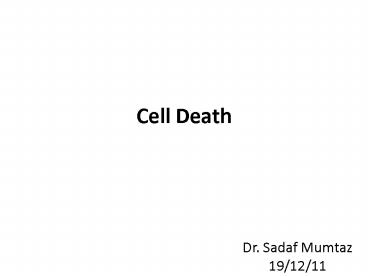Cell Death PowerPoint PPT Presentation
1 / 19
Title: Cell Death
1
Cell Death
- Dr. Sadaf Mumtaz
- 19/12/11
2
Cell Injury
- Reversible cell injury
- The functional and morphologic changes are
- reversible if the damaging stimulus is removed
- Irreversible cell injury
- With continuing damage the injury becomes
- irreversible, at which time the cell cannot
- recover and it dies
3
Causes of cell injury
Oxygen deprivation Cardiorespiratory failure, anemia, after blood loss
Physical agents Mechanical trauma, temperature, electric shock
Chemical agents and drugs Arsenic, cyanide, alcohol, insectisides
Infectious agents Viruses, bacteria, fungi
Immunological reactions Autoimmune diseases, microbes and enviromental substances
Genetic derrangements Sickle cell anaemia
Nutritional imbalances Vitamin deficiencies, Atherosclerosis
4
Cell Death
- Necrosis
- Loss of membrane integrity, enzymatic digestion
of cells, leakage of cellular contents and
frequently a host reaction - Apoptosis
- Nuclear dissolution, fragmentation of cell
without - complete loss of membrane integrity and rapid
removal - of cellular debris
5
Apoptosis
- Programmed cell death
- Process was identified in 1972
- Named after the Greek designation for falling
off
Physiological Pathological
Eliminates cells that are no longer needed and to maintain a steady number of various cell population in tissues Eliminates cells that are injured beyond repair without eliciting a host reaction, thus limiting collateral tissue damage
6
Apoptosis in physiological and pathological
conditions
The programmed destruction of cells during embryogenesis DNA damage
Involution of hormone dependent tissues upon hormone withdrawal Accumulation of misfolded proteins
Cell loss in proliferating cell populations Cell death in certain infections, particularly viral infection, tumors and cellular rejection of transplant
Elimination of potentially harmful self-reactive lymphocytes Pathological atrophy in parenchymal organs after duct obstruction, such as occurs in pancreas, parotid gland and kidney.
Death of host cells that have served their useful purpose
7
Morphological changes in apoptosis
8
Biochemical features of apoptosis
- Activation of caspases
- C refers to cysteine proteases and aspase
- refers to the unique ability of these enzymes to
- cleave after aspartic acid residues
9
Biochemical features of apoptosis
- DNA and Protein breakdown
- Ca2 and Mg2 dependent endonucleases
10
Biochemical features of apoptosis
- Membrane alterations and recognition by phagocytes
Annexin V Staining The exposed lipids are
detectable by binding of a protein called
Annexin V
11
Mechanisms of apoptosis
C Elegans
- Intrinsic or mitochondrial pathway
- The extrinsic or death receptor-initiated pathway
12
The Intrinsic (mitochondrial pathway) of apoptosis
13
The extrinsic (death receptor-initiated)
pathway of apoptosis
Bid
Activation of mitochondrial pathway
FLIP
14
Removal of dead cells
- Phospholipids fliping
- Release of soluble factors by apoptotic cells
- Thrombospondin
- Macrophages may themselves produce proteins
- Apoptotic cells may be coated with antibodies
15
Disorders associated with dysregulated apoptosis
- Defective apoptosis and increased cell survival
- Increased apoptosis and excessive cell death
- Neurodegenerative diseases
- (mutations and misfolded proteins)
- Ischemic injury, (MI and stroke)
- Death of virus infected cells
Cancers autoimmune diseases
16
Autophagy
- Cell eats its own contents
- Occurs in times of nutrient deprivation
- Autophagic vacuole---Autophagolysosome
17
Laboratory assesments of apoptosis
- DNA laddering
- Annexin 5 staining
- Flow cytometry
18
Thankyou
19
FLIP
- FLICE like inhibitory protein
- Fas-associated death domain-like interleukin
- 1ß-converting enzyme

